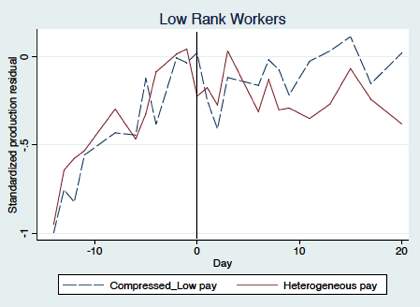
Tourism, trust and unequal pay: Recapping the IGC-SCID conference on 'Firms, trade and development'
Firm productivity and trade are well established indicators of economic growth and development. Despite this, there remain significant questions around which elements of firm organisation and market structures are the most conducive to encouraging scale and integration of firms into high-value global supply chains. Understanding the conditions that support productivity and trade will allow the forces of globalisation to be more effectively harnessed for growth in emerging markets. Today's blog looks at three innovative studies presented at Stanford University that offer insights into the effects of tourism, managerial trust, and perceptions of pay inequality on firm productivity.
Together with Stanford Center for International Development (SCID), the IGC hosted a two-day conference on trade and development in November 2015. Topics covered ranged from credit access for small firms and farms, to trade innovations and the role of regulatory policy in promoting sustainable and inclusive growth. With a focus on increasing the capabilities of firms and scaling up small enterprises, the conference brought forward new perspectives and thought-provoking ideas.
Below is a highlight of three of the main new facts presented during the conference.
#Key fact 1: Tourism can cause significant long-term economic gains, beyond the immediate effects on the service sector.
Tourism is a particular form of market integration, by which consumers instead of goods are shipped around. With the value of tourism exports amounting to almost as much as that of agriculture exports in many developing countries, tourism has grown to become one of the most visible and fastest growing forms of globalisation for these countries.
Despite widespread policy interest and a large scope for intervention however, the attention to the topic in the trade and development literature has been limited. Cecile Gaubert sought to fill that gap, with her co-author Ben Faber, as she examined the impact of Mexico’s beach-tourism on local as well as aggregate national economic outcomes. By using high-resolution satellite data they captured variations in beach quality, such as shown in the picture below, which could be used as an instrument to measure levels of tourism. To estimate local economic effects, Gaubert and Faber compared the economic activity in areas with high levels of tourism (i.e. nicer beaches) to areas with less or no tourism.
FIGURE 1: MAPPING BEACH QUALITY
Note: Authors used satellite imagery to assess beach quality along the coastline. High-quality beaches (denoted by stars on the map on the right) were used as instruments measuring tourism levels in the surrounding areas.
The authors found that tourism causes large and significant long-run local economic gains in Mexico. More specifically, a 10% increase in tourism revenues led to a 2.8% increase in employment and a 4.3% increase in nominal GDP locally. Moreover, in contrast to the existing literature on tourism and development, the authors find sizable long-run multiplier effects on manufacturing production. This meant that a 10% increase in tourism led to revenues increasing in local manufacturing GDP by 3.2%. They then interpreted these local effects through the lens of a quantitative economic geography model and found that tourism leads to significant aggregate gains in Mexican real income per capita that are in the order of 2-3 percent.
a 10% increase in tourism revenues led to a 2.8% increase in employment and a 4.3% increase in nominal GDP locally
#Key fact 2: Low willingness to delegate and lack of trust within firms may explain why some firms do not grow.
Empirical analysis of the US and other developed economies supports the idea that on average, as firms mature, they tend to increase in size and scale. This relationship is a reflection of the basic principles of efficient markets where less productive or inefficient firms, those that fail to achieve scale, will exit the market.
Strikingly, this relationships is absent in firm data gathered in India. The majority of Indian firms remain small as they age. On average, micro-enterprises and small firms (less than 10 employees) do not seem to grow substantially even after being operational for 10, 20 or 30 years.
The lack of delegations of Indian firms can then explain as much as 30-40% of the observed gap in firm size between the US and India.

Figure 2: Plant employment by age in the cross-section
Source: Hsieh and Klenow, 2014
Ufuk Akcigit, together with his colleagues Harun Alp and Michael Peters, began looking for explanations of this behaviour and wondered whether such stagnant firm behavior could be related to the fact that few Indian firms hire outside managers. Could this lack of delegation explain the slow growth of Indian firms?
To study this behaviour, the authors model the effect of failure to delegate work to other managers which limits their ability to expand operations, and hence limits firm sizes in the long-run.
The model is based on the idea that the average entrepreneur will have a limited amount of time at their disposal, delegation and cultivation of more managers is a means of allowing entrepreneurs to expand the amount of operations that a firm can handle and grow. If the owner chooses not to do this, the firm will remain small. Akcigit showed that the value of a firm decreased with size if there is no delegation, but could continue to grow if the owner delegated some responsibilities to other managers. Importantly for Indian firms, willingness to delegate is low, in general, due to lack of trust in regional authorities and constraints from managerial human capital, rule of law and contractual systems.
the value of a firm decreased with size if there is no delegation
As a conclusion, Akcigit showed how this type of behaviour would generate a very low average firm size in India at large. Firms in the US on the other hand, which does not show any such lack of willingness to delegate, would theoretically able to grow with age even if they were operating in an Indian setting. The lack of delegations of Indian firms can then explain as much as 30-40% of the observed gap in firm size between the US and India.
#Key fact 3: Perceptions of pay inequality can reduce worker motivation and productivity
A question that Supreet Kaur posed to the audience at the conference was whether workers care not only about their own pay, but also about their pay relative to that of their co-workers. Further, if workers do indeed care about relative pay, does it affect worker effort and labor supply? Together with her co-authors Emily Breza and Yogita Shamdasani, Kaur sought evidence on morale effects of pay inequality using a field experiment with workers in low-skill manufacturing firms. Relative pay has long been an important topic in the social sciences as it has potentially broad implications - for HR policies, for how workers sort into different firms as well as for how flexible wage setting policies should be, to name a few.
Kaur and co-authors set up a field experiment in Orissa, India to causally identify how workers respond to being paid differently from their peers. Male workers were hired to participate in low-skilled manufacturing tasks for a one month period. Workers were sorted into groups of 3, with each group performing a unique production task. After a short training period, during which each workers’ baseline productivity was measured, groups were randomized into two different pay structures. In some groups, all workers were paid the same wage regardless of their baseline productivity, whilst in other groups, workers were paid differentially based on their baseline productivity. This allowed for a comparison across groups of workers of the same productivity level who both earned the same absolute wage, but differed in whether their peers were paid differently from them.
For a given absolute pay level, they found that a worker exerted less effort – his output declined by 29% - when he was paid less than both of his co-workers. This was also accompanied by a 9% decline in attendance. These negative effects persisted over the duration of the employment period. In contrast, they found little evidence that performance improved if a worker was paid more than both his peers.
a worker exerted less effort – his output declined by 29% - when he was paid less than both of his co-workers
Finally, they showed that perceived justifications play an important role in mitigating these negative morale effects of low relative pay. Within a group, when workers’ baseline productivity levels were farther apart, they found no evidence for negative effects of being paid less than one’s peers. The same pattern held for production tasks where peer output was more observable—so that workers could easily observe that their higher paid peers were producing more output than themselves.

Figure 3: Average worker production, before and after treatment
Notes: This plots the average production on each day for the low productivity worker across both groups. The red line indicates the treatment group where workers are paid differently, accordingly to baseline productivity (Heterogeneous), the blue line indicates the treatment group where all workers are paid the same (Compressed). In the post-treatment period (after Day 0), we observe workers in the Heterogeneous treatment group reducing output relative to the Compressed treatment group.


